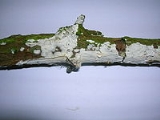
Hyphodontia sambuci
Encyclopedia
Hyphodontia sambuci or Elder Whitewash is a basidiomycete fungal pathogen on deadwood, especially elder.
It is resupinate, forming a very thin structure which is white, pruinose (flour-like dusting) or chalk
y in appearance. It is inedible. It also grows on dead but still hanging branches of Fraxinus, Berberis
, Nothofagus
, Ulmus, Populus, Hedera, Ribes
, Symphoricarpus and rarely on conifers such as Cryptomeria
.
, but there is a much bigger spectrum of substrates in warmer regions in southern areas. The variability of micromorphology increases in the tropics, but the macromorphological characteristics however always stay the same: the basidiocarp with chalky white color and often growing as aerophyte on dead branches of trees and bushes, that are still attached to the tree. H. sambuci consists of a complex of species. Similar species with capitate cystidia ; thin-walled hyphae and exactly the same chalky white fruit body are H. griselinae and H. fimbriata. The can be differentiated by their spores and morphology of their basidiocarp.
It is resupinate, forming a very thin structure which is white, pruinose (flour-like dusting) or chalk
Chalk
Chalk is a soft, white, porous sedimentary rock, a form of limestone composed of the mineral calcite. Calcite is calcium carbonate or CaCO3. It forms under reasonably deep marine conditions from the gradual accumulation of minute calcite plates shed from micro-organisms called coccolithophores....
y in appearance. It is inedible. It also grows on dead but still hanging branches of Fraxinus, Berberis
Berberis
Berberis , the barberries or pepperidge bushes, is a genus of about 450-500 species of deciduous and evergreen shrubs from 1-5 m tall with thorny shoots, native to the temperate and subtropical regions of Europe, Asia, Africa, North America and South America. They are closely related to the genus...
, Nothofagus
Nothofagus
Nothofagus, also known as the southern beeches, is a genus of 35 species of trees and shrubs native to the temperate oceanic to tropical Southern Hemisphere in southern South America and Australasia...
, Ulmus, Populus, Hedera, Ribes
Ribes
Ribes is a genus of about 150 species of flowering plants native throughout the temperate regions of the Northern Hemisphere. It is usually treated as the only genus in the family Grossulariaceae. Seven subgenera are recognized....
, Symphoricarpus and rarely on conifers such as Cryptomeria
Cryptomeria
Cryptomeria is a monotypic genus of conifer in the cypress family Cupressaceae formerly belonging to the family Taxodiaceae; it includes only one species, Cryptomeria japonica . It is endemic to Japan, where it is known as Sugi...
.
Ecology
As stated, H. sambuci occurs in North Europe mostly on Sambucus nigraSambucus nigra
Sambucus nigra is a species complex of elder native to most of Europe.It is most commonly called Elder, Elderberry, Black Elder, European Elder, European Elderberry, European Black Elderberry, Common Elder, or Elder Bush when distinction from other species of Sambucus is needed...
, but there is a much bigger spectrum of substrates in warmer regions in southern areas. The variability of micromorphology increases in the tropics, but the macromorphological characteristics however always stay the same: the basidiocarp with chalky white color and often growing as aerophyte on dead branches of trees and bushes, that are still attached to the tree. H. sambuci consists of a complex of species. Similar species with capitate cystidia ; thin-walled hyphae and exactly the same chalky white fruit body are H. griselinae and H. fimbriata. The can be differentiated by their spores and morphology of their basidiocarp.
External links
- The Virtual Field Guide.
- Index Fungorum.
- USDA ARS Fungal Database.
- http://www.searchnbn.net/gridMap/gridMap.jsp?dsKeys=GA000415%2CGA000428%2CGA000179%2CGA000468%2CEHS00005&srchSpKey=39710&col1=255%2C051%2C051&col2=255%2C153%2C051&col3=255%2C255%2C000&service=gridGBv4&width=600&height=600®ion=gbi&vcNum=0&res=1&grid=None&over=None&col=Red&date=Select+dates...&sy1=0&sy2=0&sy3=0&ey1=0&ey2=0&ey3=0&oline=Black&src=8&edit=editable+map#topOfMapThe National Biodiversity Network Gateway.]
- World Wide distribution details

